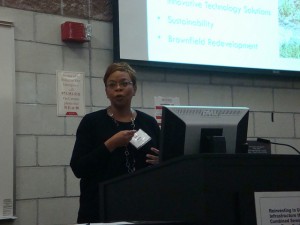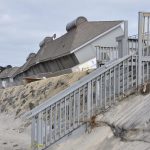New Jersey Future Blog
Workshop Attendees Learn Innovative Approaches to Addressing Combined-Sewer Overflows
January 20th, 2015 by Elaine Clisham
At a Jan. 8 workshop that focused on ways to solve combined sewer overflow (CSO) problems in New Jersey’s cities, speaker after speaker stressed to attendees the importance of tackling the problem early; of emphasizing the visible benefits of addressing the problem; and of working in tandem with other projects in order to put the most durable and cost-effective solutions in place. Or, as Carter Strickland, the former commissioner of New York City’s Department of Environmental Protection, put it, “Be early. Be opportunistic. Be codependent.”
Two urban mayors bookmarked the morning sessions, exhorting attendees to see this as a landmark opportunity to bring real revitalization to their cities. In his welcoming remarks to workshop attendees, Newark Mayor Ras Baraka emphasized the workshop’s importance. For the residents of his city, he said, addressing the CSO problem is a quality-of-life issue. Eliminating raw-sewage overflows will help to keep Newark’s newly revitalized waterfront clean, fresh and beautiful, and more generally will help make New Jersey a cleaner, greener state.
Camden Mayor Dana Redd echoed Mayor Baraka’s point about improving residents’ quality of life. “Residents should not have to worry about the weather,” she said, and about whether a routine rainfall will cause their houses and neighborhoods to flood. In addition, she stressed that dealing with infrastructure problems, especially utilizing “green” solutions, has brought with it multiple benefits for Camden: Residents have been enthusiastic about reclaiming their neighborhoods, and better infrastructure has been a key element in Camden’s economic revitalization. But, she said, the scope of the issue is bigger than just within one city, and she urged attendees to think regionally. “We are all connected by our waterways,” she said. “We are in these watersheds together.”
New Jersey cities and wastewater utilities are an unusual position, said George Hawkins, the general manager of DC Water in Washington, D.C., in that they have the opportunity to address their combined-sewer overflows before being faced with a legal judgment. This, he said, allows them to be proactive and to focus on best practices, rather than being reactive to a mandate imposed from without. For that reason, he urged attendees to begin now to develop the plans they will need to submit that detail how they will mitigate the problem.
Many of the speakers talked about the potential for green infrastructure to help address combined-sewer overflows. While no one claimed it can be the entire solution, all were enthusiastic about integrating green-infrastructure elements such as rain gardens, bioswales, and pervious pavements into the backbone of so-called “gray infrastructure,” which includes pipes and storage tunnels. Green-infrastructure projects add capacity by reducing initial inflows into the sewer system; provide visible benefits to the communities in which they’re implemented; and create much-needed local jobs.
The costs of addressing combined-sewer overflows will be significant, and currently there are few ways to finance these projects without raising rates. But Hawkins pointed out that he has raised rates several times at DC Water, to an approximate doubling of what they were when he arrived there five years ago, and said the key to ratepayer acceptance was embodied in Strickland’s second exhortation: “Be opportunistic.” Find and partner with community and environmental organizations who want the public-health threats from combined sewers addressed, and who will benefit from greener, more vibrant neighborhoods and from projects’ job creation, and involve them in advocating for implementation of green-infrastructure elements. Unlike visible, above-ground improvements that benefit the surrounding community, Hawkins said, a tunnel, while effective, is invisible, making its cost much harder to justify.
In addition to partnering with other organizations, Strickland urged attendees to break down silos and coordinate with other departments and agencies and to integrate improvements with other projects wherever possible. The cost of repaving a parking lot may be in some other public works budget already, he said, so the cost of paving it with pervious materials may involve a smaller incremental cost.
Overall, the speakers stressed that fixing New Jersey’s CSO problems constitutes a generational opportunity to leave a positive legacy, offering the opportunity not just for greening our cities but also for growing them.
The workshop was organized by New Jersey Future, the New Jersey Dept. of Environmental Protection (DEP) and the U.S. Environmental Protection Agency Region 2, in anticipation of permits that will soon be issued to all operators of combined-sewer systems. These permits will require system operators to submit long-term control plans that address the problem of combined-sewer overflows. More information on the DEP permits.
Presentations and video from the workshop will be posted on the DEP website. For additional resources, including a best-practices white paper and a sample RFP for long-term control plan development, please see New Jersey Future’s urban water infrastructure page.

















